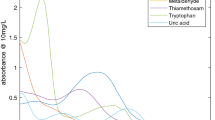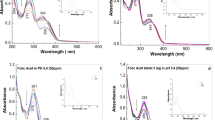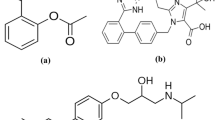Abstract
THE use of ultra-violet light to detect and photograph chromatographed compounds absorbing in the region of 254 mµ is well known1. In the course of investigating a number of unknown compounds found on chromatograms of plasma extracts, a simple technique was developed for photographing spots which fluoresce in ultra-violet light at 360 mµ. This consists of interposing a Kodak 2A gelatin filter, which absorbs radiant energy below 405 mµ, between the chromatogram and the contact paper (‘Kodabromide F5’). The filter is enclosed for protection between 1/16 in. glass plates, bound with tape at the edges. The chromatogram is exposed for approximately 30 sec. to ultra-violet light from a 365-mµ source (‘Mineralight’ handlamp, Ultraviolet Products, Inc., San Gabriel, Calif.) at a distance of 1 ft. The photograph is then developed in the usual way.
This is a preview of subscription content, access via your institution
Access options
Subscribe to this journal
Receive 51 print issues and online access
$199.00 per year
only $3.90 per issue
Buy this article
- Purchase on Springer Link
- Instant access to full article PDF
Prices may be subject to local taxes which are calculated during checkout
Similar content being viewed by others
References
Markham, R., and Smith, J. D., Biochem. J., 45, 294 (1949).
Smith, J. D., and Markham, R., Biochem. J., 46, 509 (1950).
Author information
Authors and Affiliations
Rights and permissions
About this article
Cite this article
ABELSON, D. Ultra-Violet Photography of Fluorescent Spots on Chromatograms of Biological Extracts. Nature 188, 850–851 (1960). https://doi.org/10.1038/188850a0
Issue Date:
DOI: https://doi.org/10.1038/188850a0
This article is cited by
Comments
By submitting a comment you agree to abide by our Terms and Community Guidelines. If you find something abusive or that does not comply with our terms or guidelines please flag it as inappropriate.



